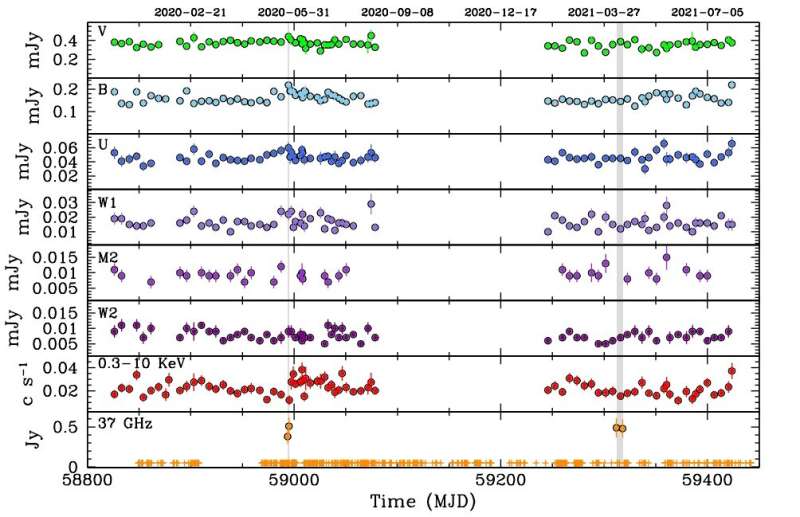March 23, 2023 report
This article has been reviewed according to Science X's editorial process and policies. Editors have highlighted the following attributes while ensuring the content's credibility:
fact-checked
preprint
trusted source
proofread
Study explores a nearby narrow-line Seyfert 1 galaxy

An international team of astronomers has conducted a long-term multiwavelength monitoring campaign of a nearby narrow-line Seyfert 1 galaxy known as SDSS J164100.10+345452.7. Results of the observations, published March 9 on the pre-print server arXiv, deliver important insights into the nature of this object.
Narrow-line Seyfert 1 (NLS1) galaxies are a class of active galactic nuclei (AGN) that have all the properties of type 1 Seyfert galaxies, but show peculiar characteristics like narrow Balmer lines, strong Fe II emission, and extreme properties in the X-rays.
At a redshift of 0.164, SDSS J164100.10+345452.7 (or J1641 for short) is a nearby NLS1 detected in radio and gamma-ray bands. Previous studies of J1641 have suggested that it may host an unknown class of relativistic jets, completely undetectable at low radio frequencies, that is where most observations of this NLS1 have been performed so far.
Therefore, in order to verify this and get more insights into the nature of J1641, a group of astronomers led by Patrizia Romano of the Brera Observatory in Italy has observed this AGN in various wavelengths using NASA's Swift spacecraft and the Aalto University Metsähovi Radio Observatory in Finland.
"In this paper, we report on a 2-year multi-wavelength (optical, ultraviolet, and X-ray) monitoring of J1641 with the Neil Gehrels Swift Observatory (Gehrels et al. 2004) that was performed in 2019–2021 simultaneously with 37 GHz observations obtained as part of the Metsähovi NLS1 monitoring program," the researchers wrote.
The multiwavelength observations unveiled significant variability in the light curves of J1641 that is smaller than variability reported in the literature for the best six well-known gamma-NLS1s. The time-selected X-ray spectroscopy shows that the galaxy is remarkably stable during the two years of monitoring.
During the two-year observational campaign, two distinct radio flaring episodes were identified—one each year. Based on the analysis of the X-ray spectra preceding and following the first radio flare, it was found that the average spectrum of J1641 can be best described by an absorbed power law model with a photon index of approximately 1.93, modified by a partially covering neutral absorber.
Moreover, it was found that the X-ray spectrum closest to the radio flare, however, does not require extra absorption and is much harder. The astronomers assume that this points to the emergence of a further, harder spectral component, which they interpret as the jet emission peeking out of a gap in the absorber.
The researchers added that if the radio emission from J1641 is due to a jet, then its power would be at a level of 42.54 erg/s. This is one of the lowest measured values when compared with other known NLS1 galaxies, and reminiscent of the gamma-NLS1 J0706+3901.
More information: P. Romano et al, Long-term Swift and Metsähovi monitoring of SDSS J164100.10+345452.7 reveals multi-wavelength correlated variability, arXiv (2023). DOI: 10.48550/arxiv.2303.05534
Journal information: arXiv
© 2023 Science X Network





















